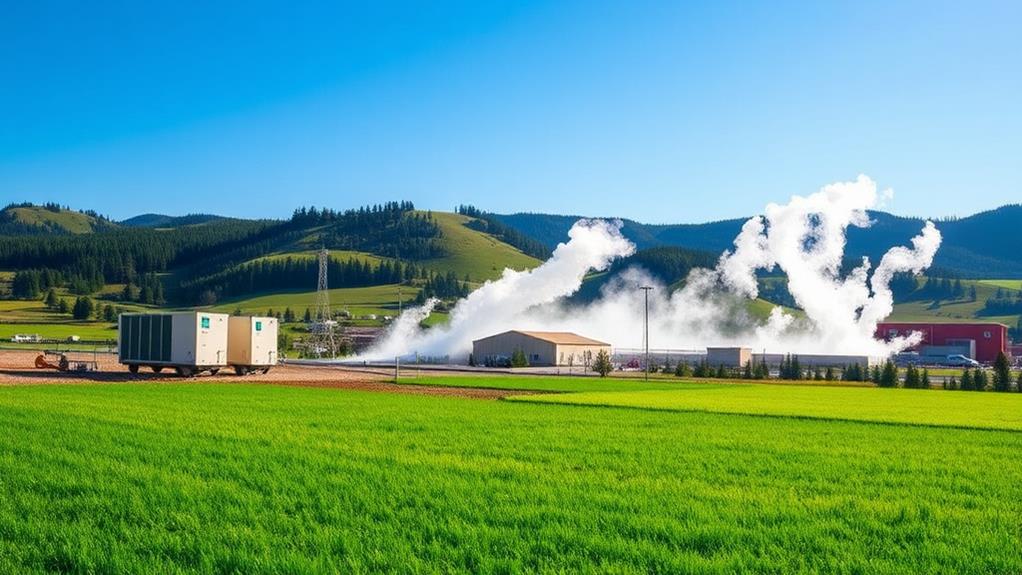When evaluating wind turbine costs versus size, consider several factors. Onshore turbines typically range from $2.5 million to $4 million, while offshore models can exceed $100 million due to their larger capacities, which can reach up to 18 MW. Manufacturing costs account for approximately 70% of total expenses, with rotor blades and nacelles being significant contributors. Transportation and installation costs, often surpassing $100,000, vary based on location and turbine size. Annual operational costs for onshore units range from $42,000 to $48,000, indicating varying return on investments depending on efficiency and location. Further insights await your exploration of related details.
Key Takeaways
- Industrial turbines have higher costs and capacities, with offshore models exceeding $100 million and onshore ranging from $2.5 to $4 million.
- Residential turbines are more affordable, costing between $20,000 and $80,000, but may not fully power a home.
- Commercial turbines cost about $1.3 million per MW and produce significant energy, with onshore models generating around 800,000 to 1,000,000 kWh monthly.
- Manufacturing accounts for 70% of turbine costs, with rotor blades and nacelles being significant contributors.
- Transportation and installation expenses can add 3-8% to overall costs, especially in remote locations or for larger turbines.
Understanding Wind Turbine Types
When it comes to understanding wind turbine types, it's essential to recognize the diversity in their capacities and applications. Industrial wind turbines typically range from 2 to 3 MW for onshore installations, whereas offshore wind farms can reach capacities of up to 18 MW. The initial costs for these larger turbines can soar above $100 million, highlighting their substantial investment demands. Conversely, residential wind turbines, rated under 100 kW, offer homeowners a more affordable option, with system costs between $20,000 and $80,000. Commercial turbines average about $1.3 million per MW capacity, and maintenance costs can add 1-2 cents per kWh produced, emphasizing the ongoing financial commitment tied to not only turbine size but also energy production efficiency.
Evaluating Manufacturing and Component Costs
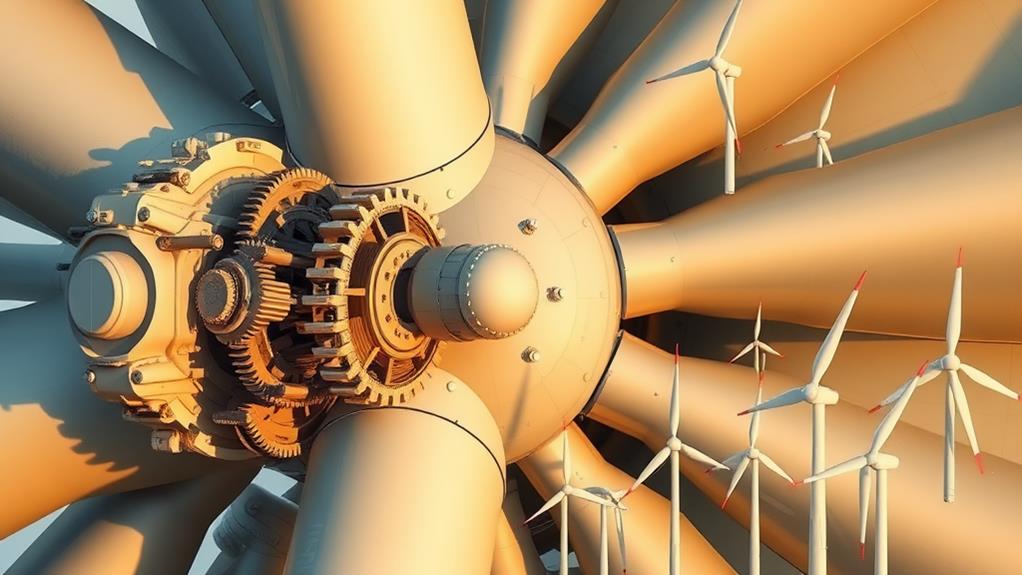
When you evaluate manufacturing and component costs for wind turbines, it's essential to understand that manufacturing represents about 70% of total expenses, with significant variations influenced by size, materials, and the country of origin. Remarkably, rotor blades, which account for approximately 20% of total costs, can vary dramatically in price, reaching over $1 million depending on their specifications. Additionally, the nacelle's contribution of around 35% underlines the importance of quality components, while factors such as labor and raw material costs further complicate the overall pricing landscape.
Manufacturing Cost Breakdown
Understanding the manufacturing cost breakdown of wind turbines is essential for evaluating their overall expenses. Manufacturing accounts for approximately 70% of total turbine costs, influenced by factors like size, materials, and country of origin. Here's a closer look at the key components:
- Rotor Blades: Represent about 20% of total turbine costs, with prices ranging from $500,000 to over $1 million, depending on size and materials used.
- Nacelle: Housing the generator and gearbox, the nacelle constitutes around 35% of total expenses, underscoring its importance in turbine functionality.
- Tower Construction: While simpler, the design and materials greatly impact overall costs, especially as turbine sizes increase, leading to more complex engineering requirements.
Component Pricing Influences
Evaluating the pricing influences of wind turbine components reveals how various factors can greatly impact overall manufacturing costs. Manufacturing costs account for about 70% of total turbine expenses, with rotor blades alone contributing approximately 20%, often ranging from $500,000 to over $1 million based on material choice and design. The generator expense within the nacelle comprises around 35% of total turbine costs, reflecting its complexity and durability. Additionally, transportation costs for oversized components like rotor blades can represent 3-8% of overall expenses due to their special handling requirements. While tower construction is simpler, it still greatly influences total turbine expenses, highlighting the importance of efficient design and material selection in optimizing component pricing and managing overall wind turbine costs.
Size and Material Impact
The scale of wind turbines plays an essential role in determining manufacturing and component costs. Larger offshore turbines, ranging from 6 to 12 MW, greatly influence total expenses, which can exceed tens of millions of dollars. Key factors include:
- Rotor Blades: Representing about 20% of wind turbine costs, their pricing varies based on materials like glass fiber and hybrid glass-carbon fiber.
- Nacelle Complexity: Comprising approximately 35% of total costs, the intricacy of the gearbox affects maintenance costs over their 25-year lifespan.
- Transportation Costs: As oversized loads, larger components can account for 3-8% of overall expenses, complicating logistics and increasing costs.
Understanding how size and materials impact wind turbine costs is essential for optimizing efficiency and investment strategies within the renewable energy sector.
Analyzing Transportation and Installation Expenses
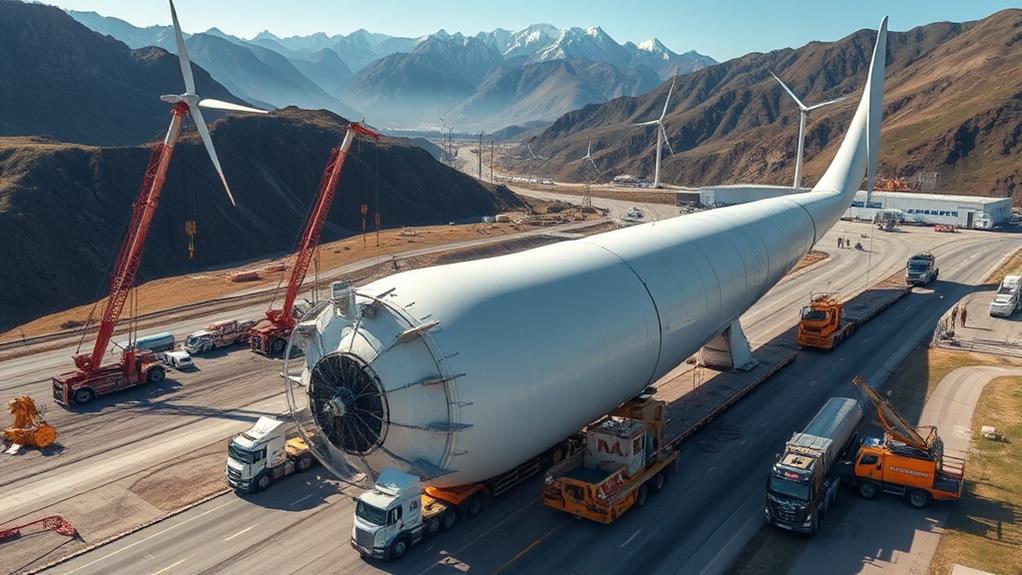
When analyzing transportation and installation expenses for wind turbines, it's essential to take into account several cost factors, including the distance to the installation site and the complexities involved in the installation process. Transportation costs can range from 3-8% of overall wind power expenses, greatly impacted by the size of the turbine, particularly given that blades are classified as oversized loads and require specialized handling. Additionally, installation expenses, which may exceed $100,000, encompass foundation construction and crane rentals, with remote locations further inflating these costs, emphasizing the importance of meticulous planning in project budgeting.
Transportation Cost Factors
Transportation costs can represent 3-8% of the total expenses in wind power projects, and they're heavily influenced by factors like turbine size and installation location. To guarantee you're prepared for these costs, consider these key factors:
- Turbine Size: Larger turbines incur higher transportation costs due to logistical challenges, requiring specialized vehicles for oversized loads and special handling.
- Remote Installation Sites: Increased travel distances and accessibility issues raise both transportation and installation costs considerably.
- Installation Costs: Foundation construction, crane rentals, and electrical grid wiring can add over $100,000 to overall wind power expenses, particularly for remote locations.
Understanding these factors helps you anticipate the financial implications of transportation costs in your wind energy projects, guaranteeing better planning and execution.
Installation Site Challenges
Understanding transportation costs sets the stage for recognizing the challenges posed by installation sites. Installation costs can skyrocket, often exceeding $100,000, particularly influenced by turbine size and site remoteness. Handling oversized loads, especially turbine blades, complicates logistics, leading to increased transportation costs of 3-8% of overall wind power expenses. In addition, remote locations may require additional site preparation, which can greatly impact total expenses. The necessity for foundation construction and crane rentals, combined with grid wiring, adds layers of complexity. Proper planning and assessment of these factors are essential to minimize unexpected expenses and delays. Ultimately, managing installation site challenges requires a thorough approach to logistics, emphasizing the importance of detailed project management.
Foundation Construction Expenses
Foundation construction expenses often play an essential role in determining the overall installation budget for wind turbines. These costs can greatly impact your bottom line, particularly for large offshore turbines that require more robust designs. Here are key factors to reflect upon:
- Foundation Design Complexity: Larger turbines demand intricate designs, increasing costs.
- Excavation and Site Preparation: Effective site preparation is vital for turbine stability and can add to installation expenses.
- Logistical Challenges: Remote locations may face heightened foundation construction costs due to specialized transport requirements.
Assessing Energy Output Variability
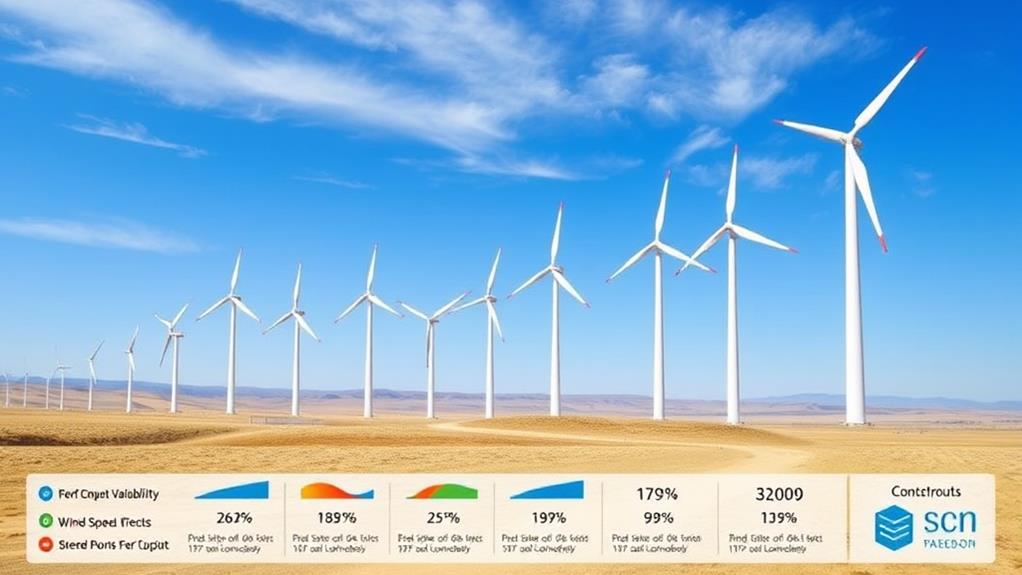
When evaluating the energy output variability of wind turbines, it's essential to take into account factors like capacity factors and wind conditions. Onshore models generally operate at a capacity factor of 30-40%, meaning they produce only 30-40% of their maximum potential due to variable wind speeds. In contrast, offshore turbines benefit from more consistent wind patterns, achieving capacity factors of up to 65% or higher, greatly boosting their energy output. A 1 MW turbine can power around 1,000 homes monthly, but actual electricity production often falls short due to fluctuating conditions. Larger turbines, rated at 12-15 MW, can produce up to six times more electricity than typical onshore units, underscoring how size impacts overall energy output and commercial wind turbine costs.
Exploring Operation and Maintenance Costs
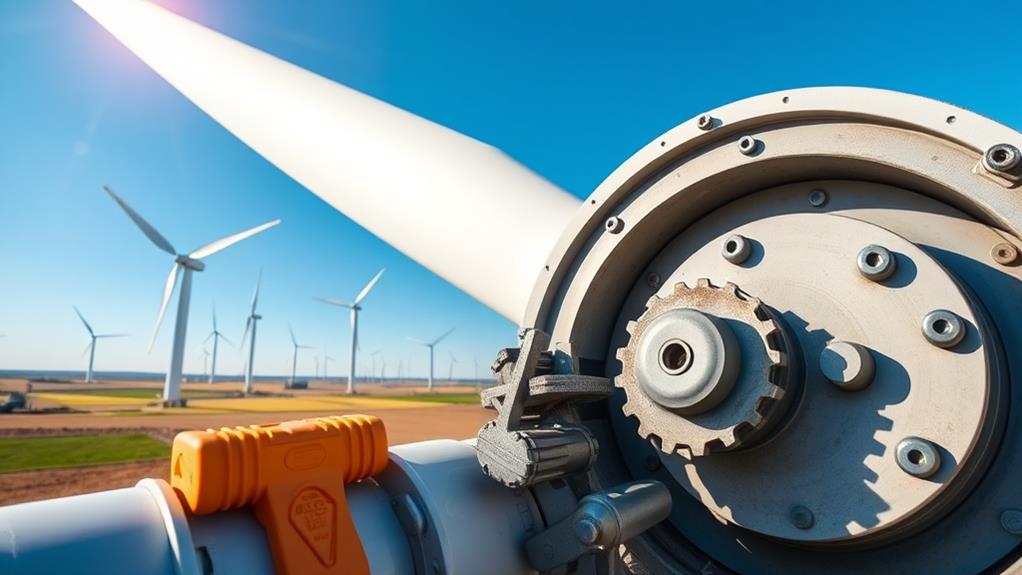
Operation and maintenance (O&M) costs play an essential role in the overall economics of wind energy. Understanding these recurring costs is significant for evaluating the viability of wind turbines. Here are three key factors to examine:
- Annual Operational Costs: In the U.S., these range from $42,000 to $48,000, translating to 1-2 cents per kilowatt-hour produced.
- Maintenance Expenses: As wind turbines age, these costs typically increase due to wear and tear, necessitating more frequent servicing.
- Offshore vs. Onshore: Offshore wind turbines face higher O&M costs due to logistical challenges and the need for specialized labor.
Effective maintenance strategies are critical for maximizing efficiency and prolonging the long lifespan of commercial models, which can last 20-30 years.
Comparing Residential and Commercial Turbines
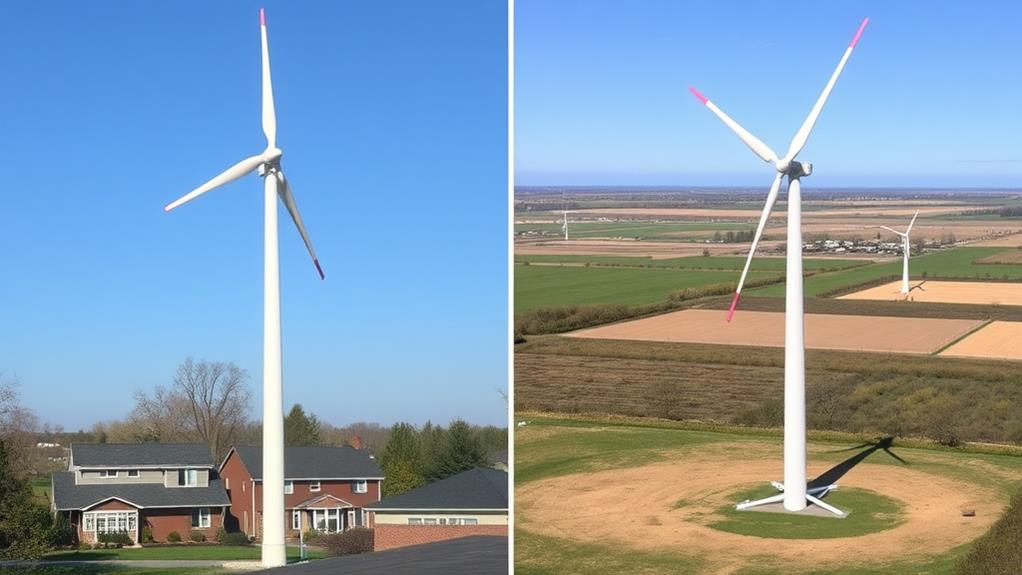
Many homeowners and businesses are considering wind turbines as a renewable energy solution, but there's a stark contrast between residential and commercial systems. Residential wind turbines generally range from $20,000 to $80,000 for complete systems, with smaller models costing between $500 and $15,000, though these often fall short of powering an entire home. In contrast, commercial turbines have average costs around $2.5 million to $4 million, with larger offshore models exceeding $100 million, influenced by capacity and installation factors. Onshore commercial turbines produce approximately 800,000 to 1,000,000 kWh monthly, showcasing a significant scale difference in energy output compared to residential systems, which typically generate 700 to 1,700 kWh per month. The average cost for commercial turbines is about $1 to $1.25 million per megawatt.
Considering Long-Term Investment Returns
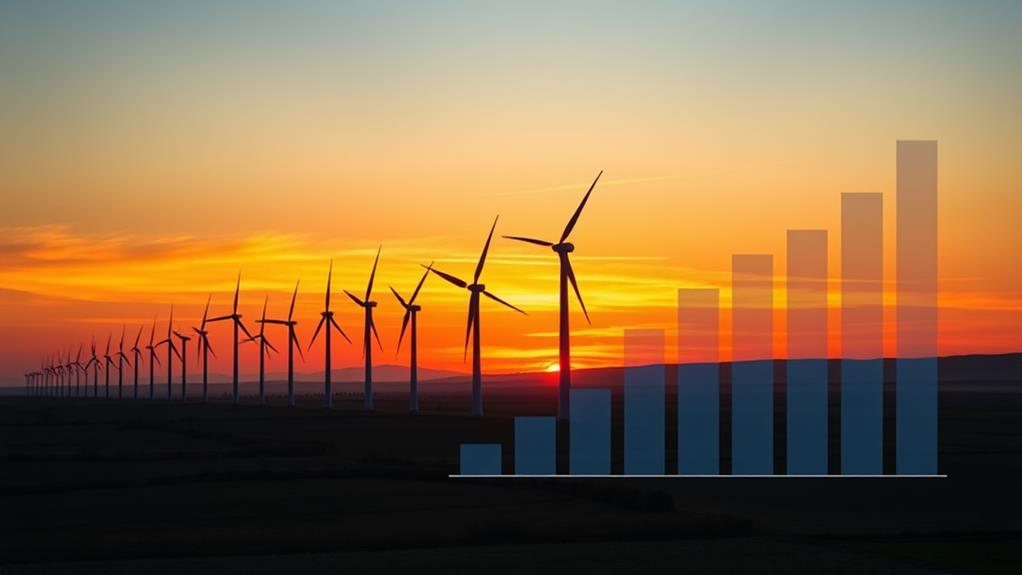
Investing in wind turbines presents a unique opportunity for homeowners and businesses alike, but understanding the long-term financial implications is key. To maximize your return on investment (ROI), consider these factors:
- Initial Costs: Onshore commercial turbines average between $2.5 to $4 million, while offshore turbines can exceed $100 million.
- Maintenance Expenses: Annual costs for onshore turbines range from $40,000 to $50,000, impacting overall profitability.
- Energy Production Capacity: Onshore turbines typically produce at 30-40% efficiency, contrasting with offshore turbines at up to 65%, underscoring the importance of turbine size and location.
With an ROI timeframe of 12 to 20 years influenced by these elements, careful planning can lead to substantial long-term investment returns.
Frequently Asked Questions
What Is the Most Expensive Part of a Wind Turbine?
In the intricate dance of renewable energy, the generator reigns supreme as the priciest turbine component. With maintenance costs and installation expenses intertwining, its efficiency profoundly shapes energy output, impacting environmental sustainability and market trends alike.
How Do I Calculate What Size Wind Turbine I Need?
To calculate your wind turbine size, assess your site's wind conditions, local regulations, and energy needs. Consider turbine capacity, installation process, maintenance, and financing options for ideal energy output and environmental impact monitoring.
What Is the True Cost of Wind Turbines?
What's the true cost of wind turbines, you wonder? Consider installation expenses, maintenance costs, energy output, and financing options. With tax incentives and technological advancements, you'll find environmental benefits outweigh project budgets and location impact.
What Is the Profit Margin on Wind Turbines?
When evaluating wind turbine profit margins, consider factors like operational expenses, maintenance costs, energy pricing, and market demand. Technology advancements and financing options can enhance profitability, while regulatory impacts and lifespan considerations play essential roles too.

